NYC’s Forgotten ‘War on Christmas Trees’
Discover how an obscure holiday crackdown affects festive street vendors today!


Downtown Manhattan is not only filled with history, but it is also filled with numerous permanent art installations – many of which are part of the history we so lovingly preserve. Beginning at Bowling Green in The Battery, view artifacts of the oldest man-made structure still in place in Manhattan, look down into a cistern from the 18th-century, and view remnants of a tavern from the 1800s. Ponder artists’ portrayals symbolizing hope, optimism and whimsy. Many survived the attacks of September 11, proudly showing their dents and holes.
Our list of twenty permanent installations will take you from The Battery, past Brookfield Place to Nelson A. Rockefeller Park, along the lower Manhattan shoreline.
See many of these on our walking tour of the Public Art in Lower Manhattan:
Public Art Tour in Lower Manhattan
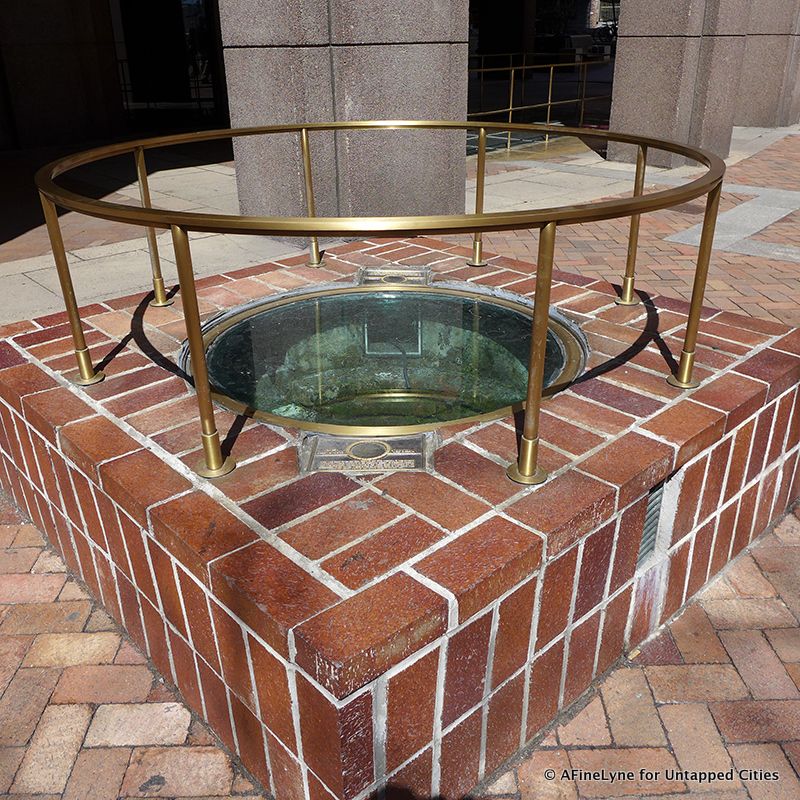
Excavations have often given us glimpses into life in the early days of the colony. An early 18th century well was uncovered that is said to have resided on land belonging to longtime residents, the Philipse family of Philipse Manor. The well extended down to the waterline, reminding us that the East River’s waterfront once ran along what is now Pearl Street, and that a portion of downtown Manhattan was actually physically constructed as the colony grew.
The cistern provided water to the entire block, and when the waterline was pushed back, and it was no longer used, it was filled with everyday items – it became a trash receptacle. Having a cistern installed at this location tells us that the neighborhood was evolving, with old buildings coming down and new buildings going up. The cistern can be viewed on the plaza at 85 Broad Street and is a stop on our tour of the Remnants of DUtch New Amsterdam:
Tour of The Remnants of Dutch New Amsterdam
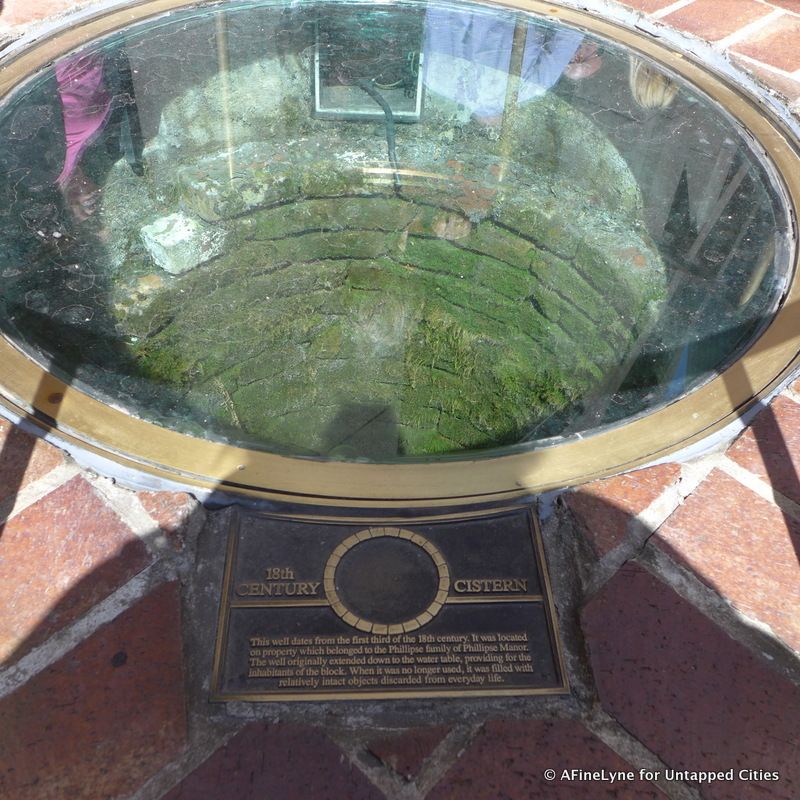
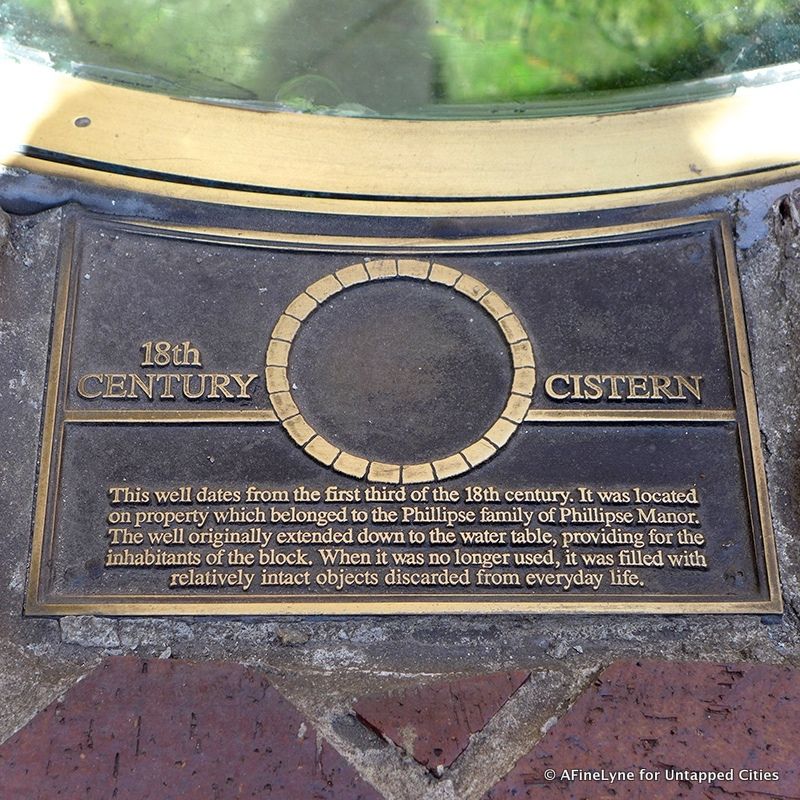
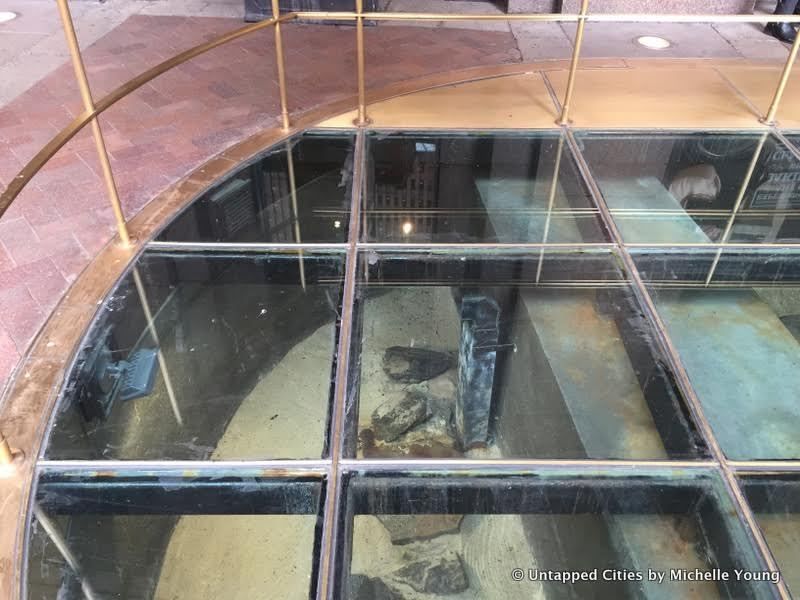
Before becoming the city’s Financial District, downtown Manhattan was home to some of New York City’s oldest establishments. One of them, the Lovelace Tavern at 85 Broad Street, dates back to the Dutch settlement of Manhattan as one of the first taverns in the city. Built by former New York Governor Franklin Lovelace in 1670 (on top of land that first housed Stadt Huys, the city’s first city hall), it served as a place to meet over wine, beer and tobacco. The tavern was lost in a fire in 1835, but underground remnants remained. The remnants were discovered in 1979 during the construction of 85 Broad Street by Goldman Sachs, and preserved for curious New Yorkers to find, if they look down on their way to work. As the Observer reported, “it was one of the most expensive urban archeological digs ever in America “at the time.
See both the cistern and the tavern foundations on our tour of the Remnants of Dutch New Amsterdam:
Tour of The Remnants of Dutch New Amsterdam
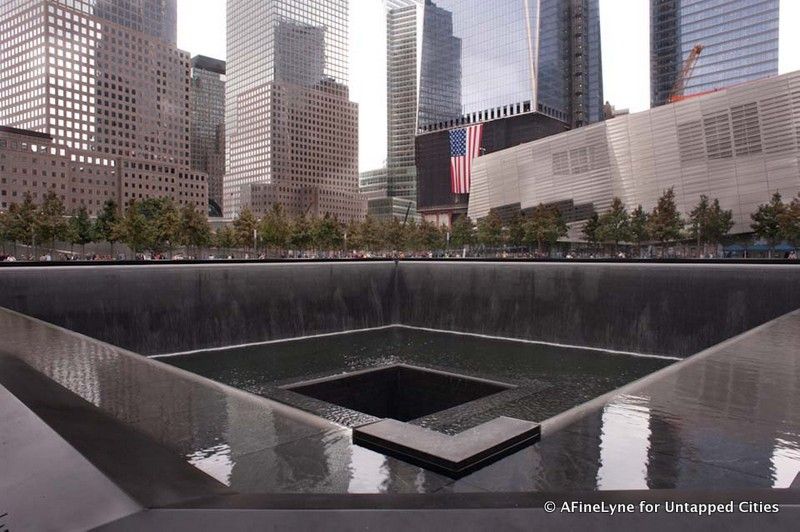
The National September 11 Memorial honors the nearly 3,000 people killed in the terror attacks at the World Trade Center site, Shanksville, Pennsylvania and the Pentagon, as well as the six people killed in the World Trade Center bombing in February, 1993. Each reflecting pool is almost an acre in size, featuring the largest manmade waterfalls in North America and occupying the space within the footprints of where the Twin Towers once stood. The names of every person who died in 2001 and 1993 are inscribed at the site.
Also on site is the 9/11 Memorial Museum, which houses a growing collection of artifacts from the attacks. The Museum is divided into three sections: historical exhibitions, the memorial exhibition which commemorates the lives of those who perished, and Foundation Hall – a room which contains both the last column and the slurry wall.
The National September 11 Memorial is located at 180 Greenwich Street. Visitors can also access the Memorial at the intersection of Liberty Street and West Street. Tickets to the official September 11 Memorial guided tour and Museum admission are for sale here.
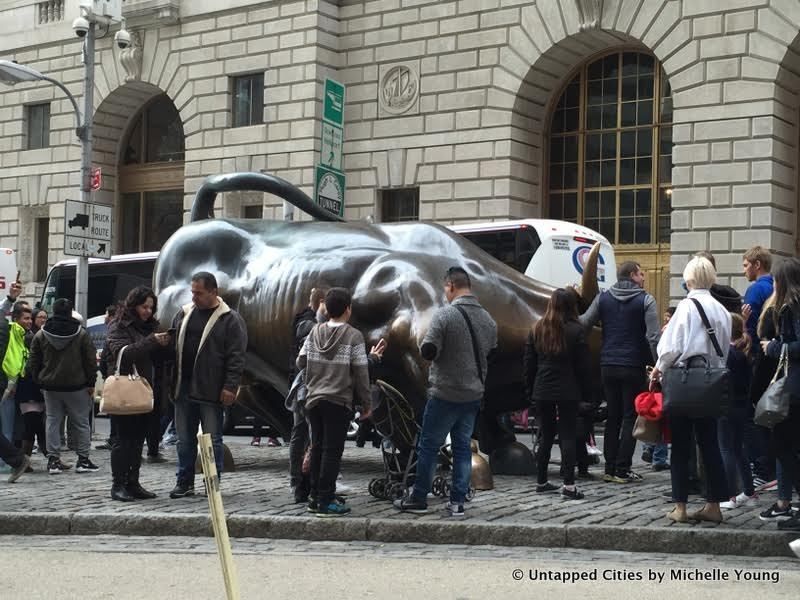
Charging Bull by sculpture artist Arturo di Modica, often referred to as the Wall Street Bull, is a bronze sculpture standing eleven feet tall and sixteen feet long. It represent aggressive financial optimism and prosperity, and is a Wall Street icon. The installation was created and installed following the 1987 stock market crash as a symbol of the strength and power of the American people. This was not a commissioned piece.
The artist, who spent $360,000 to create the piece, trucked it to lower Manhattan on December 15, 1989 and installed it in the middle of Broad Street, in front of the New York Stock Exchange as a Christmas gift to the people of New York. The police seized the sculpture and placed it in an impound. But public outcry led to the New York Department of Parks and Recreation installing it two blocks south of the exchange in the plaza at Bowling Green on December 21, 1989, where it resides today mobbed by tourists.
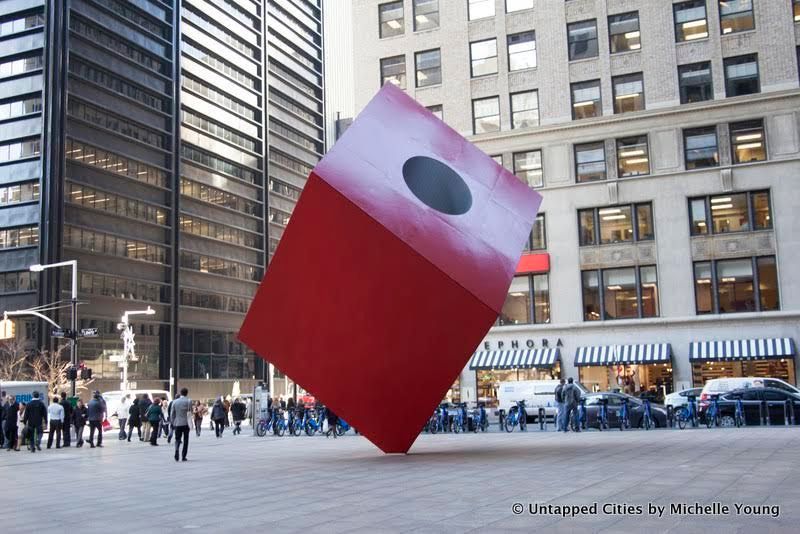
Red Cube by Isarmu Noguchi
Red Cube by artist Isarmu Noguchi (1904-1988) was installed in 1968 in front of 140 Broadway. The giant red cube stands twenty-eight feet high and is steel, cast in aluminum. Through the center of the cube there is a cylindrical hole with a gray surface. It is surrounded on three-sides by skyscrapers. You may recall the artist’s name from last years celebration of the 100th anniversary of the Brooklyn Botanic Garden’s Japanese Hill and Pond, with a collaboration with the Noguchi Museum. Be sure to check out Noguchi’s Sunken Garden, next on this list.
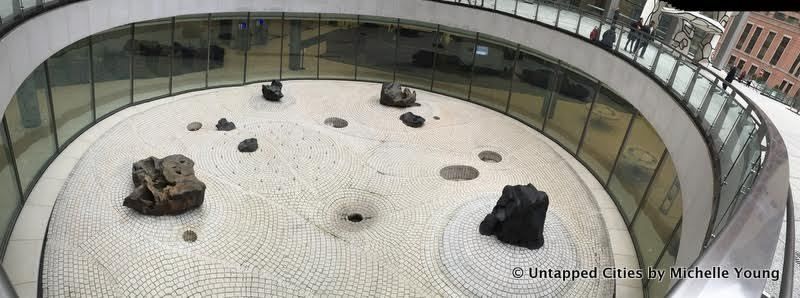
Sunken Garden by Isarmu Noguchi
The sloped ground of the installation Sunken Garden is composed of 27,000 four-inch-quart granite stones from Vermont. In true Noguchi style, it has the feeling of a Zen garden, with its cobblestone pathways. In the summer, the garden acts as a fountain. It remains dry in the winter. Sunken Garden is located at 28 Liberty Street, formerly known as One Chase Manhattan Plaza. You can learn more about Isamu Noguchi at the Noguchi Museum in Long Island City.
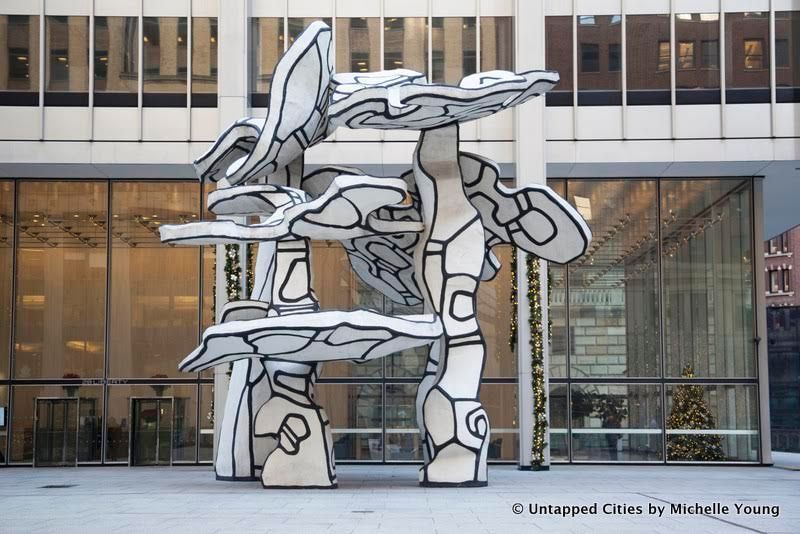
Group of Four Trees was commissioned in 1969 by David Rockefeller, to be placed in front of the Chase Manhattan Building. It is part of a larger group of pieces that Dubuffet calls L’Hourloupe, which translates to mean “some wonderland or grotesque object or creature.” Dubuffet refers to this series as “drawings which extend and expand in space.” Group of Four Trees was unveiled in 1972 and is on view at 28 Liberty Street, next to Noguchi’s Sunken Garden.
Jean Dubuffet will also have an exhibit this month at Acquavella Galleries. The exhibit entitled Anticultural Positions will be on view from April 15 through June 10, 2016. Acquavella Gallery is located at 18 East 79th Street.
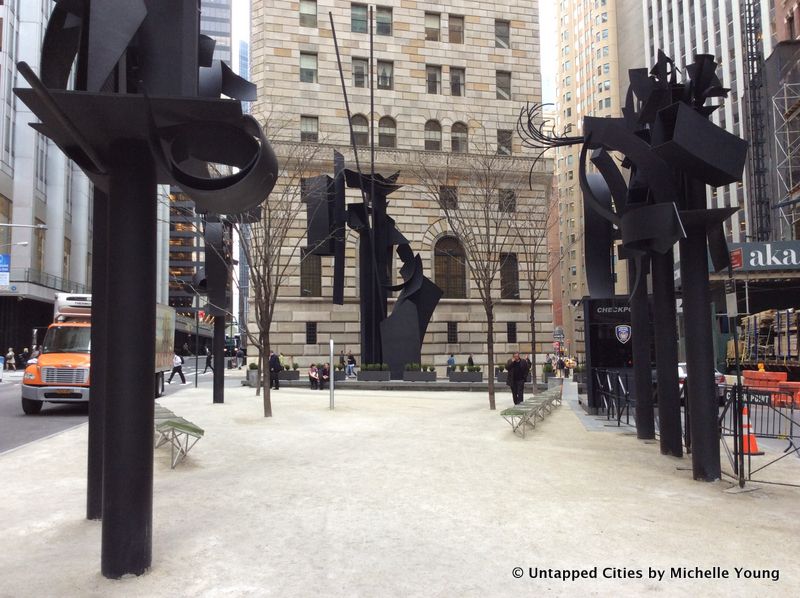
This park was originally designated Legion Memorial Square in 1977 under Mayor Abe Beame. The following year, 1978, Mayor Ed Koch proclaimed the site Louise Nevelson Plaza and installed seven sculptures titled Shadows and Flags (1977-78). Nevelson, who lived in New York City for over sixty years, initially designed the entire plaza. But after it fell into disrepair, a redesign took place in 2010, adding new benches and greenery. The largest of her sculptures stands seventy feet tall, and acts as a stage for organized outdoor events. The Louise Nevelson Plaza is located at 84 Williams Street.
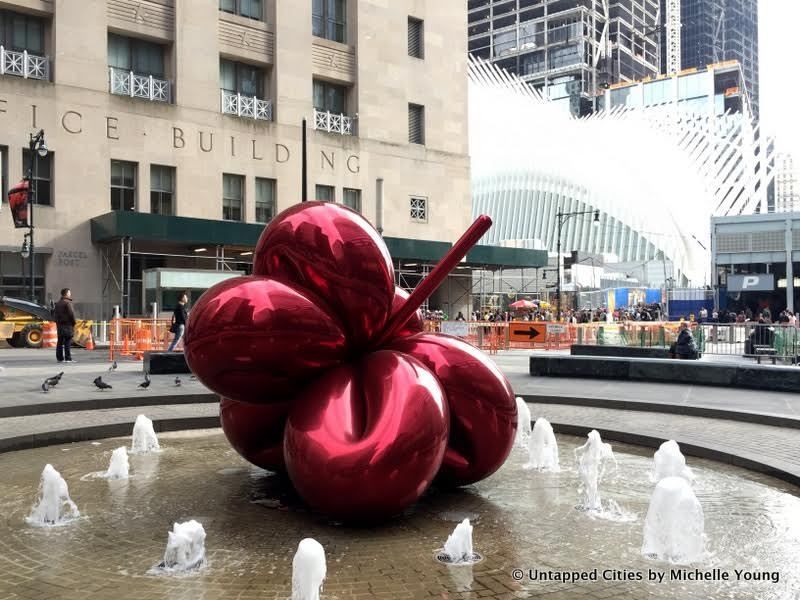
Balloon Flower by Jeff Koons
Balloon Flower is one of five sculptures (1995-99) in a series by Jeff Kooons with colors like magenta, blue, yellow, orange. The red version is located at 7 World Trade Center on Greenwich Street. The nine-foot high, stainless steel sculpture is located in a circular fountain in a triangular park. It consists of six large blossoms, or balloon-like shapes of various sizes, and one flower stem.
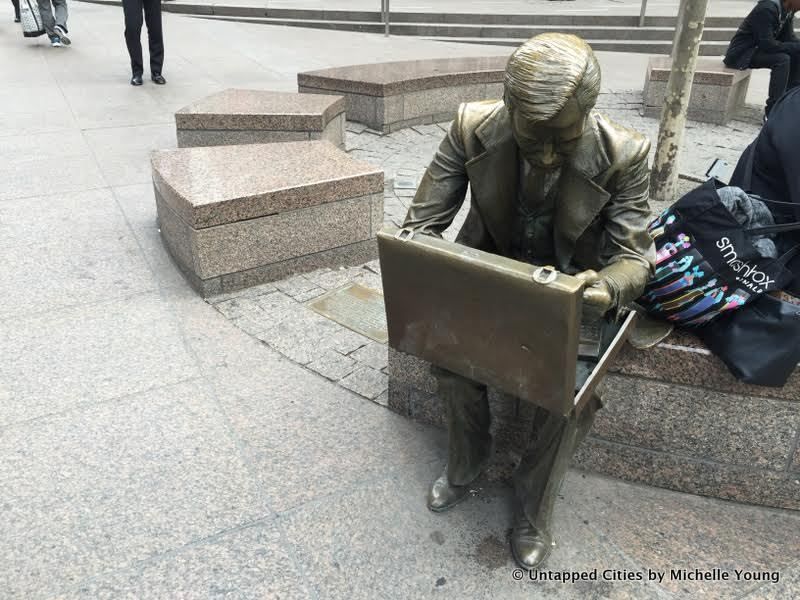
The life-sized bronze statue entitled Double Check was created in 1982 by artist Seward Johnson. It was loaned to Merrill Lynch to be displayed in what was then Liberty Park. In the weeks following September 11, with the park surrounded by debris, Double Check became a symbol of the World Trade Tower victims. Seward Johnson brought the sculpture back to his studio, where he cast a duplicate and added objects left by mourners. He also refurbished the original, leaving the damages, and returned it to the park. The plaque reads “a poignant reminder of hope and endurance for us all.” In 2006, Liberty Plaza Park was renovated and renamed Zuccotti Park.
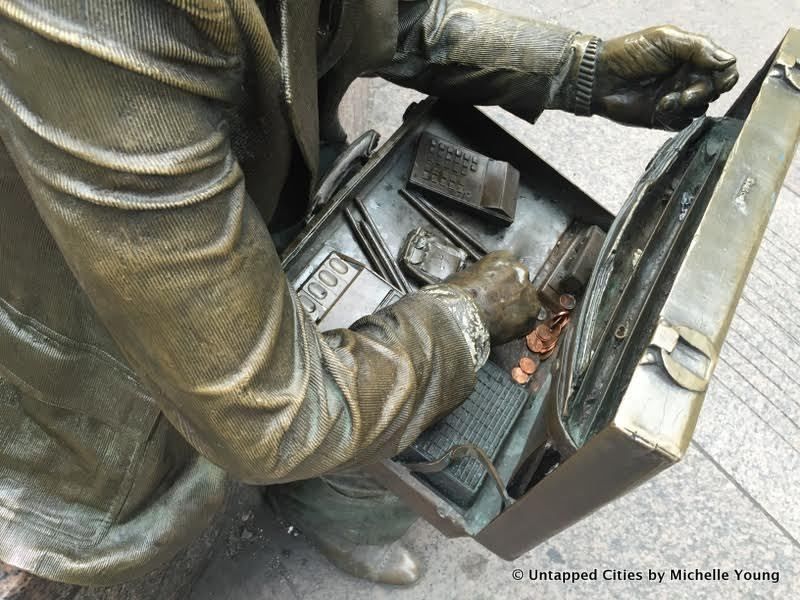
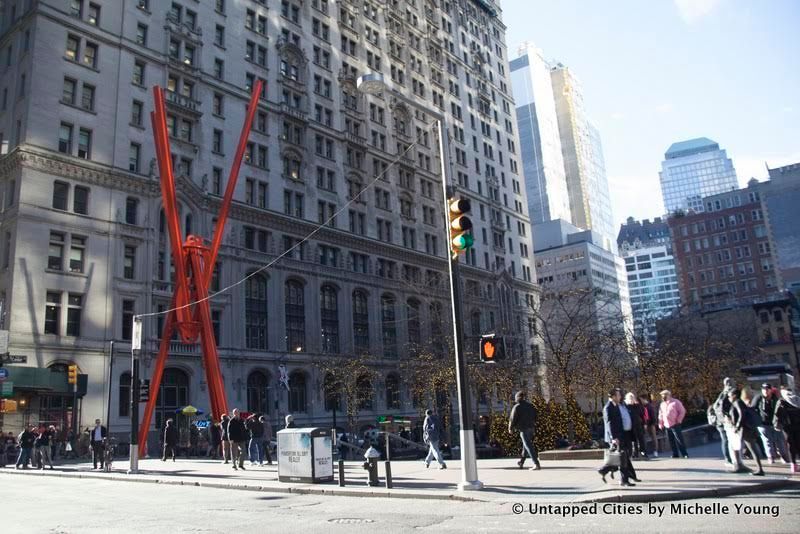
Joie de Vivre by artist Mark di Suvero in Zuccotti Park
The seventy-foot steel installation entitled Joie de Vivre (meaning “The Joy of Life” in French) arrived in 2006 to Liberty Plaza, which is now Zuccotti Park. The artist, Mark di Suvero has a history of activism, having left the United States for five years in opposition to the Vietnam war. So it is quite fitting that Joie de Vivre became a focal point and meeting place during Occupy Wall Street. Signs were posted on it, occupiers and journalists climbed on it, marchers met there and speeches were given. This is the fourth location in a decade for this installation. It was first located at the Esplanades des Invalides in Paris, then Storm King Art Center in New York, and the rotary of the Holland Tunnel before finding its current permanent home, Zuccotti Park.

In 2005, while building a new South Whitehall Street station complex, builders working on the new station found remains of a 200-year-old stone wall. After careful analysis, it was found to be the oldest man-made structure still in place in Manhattan. 250,000 individual artifacts and four walls were found in the excavation. A portion of one wall was placed on temporary display inside Castle Clinton. Another portion of the historic wall was embedded permanently into the entrance of the newly constructed station.
Robert Tierney, Chairman of the New York City Landmarks Preservation Commission said “This wall most likely is a portion of the gun batteries that once protected the city in the late 17th and 18th centuries, and gave rise to the modern park name.” The historic wall is on permanent display at the new station complex.
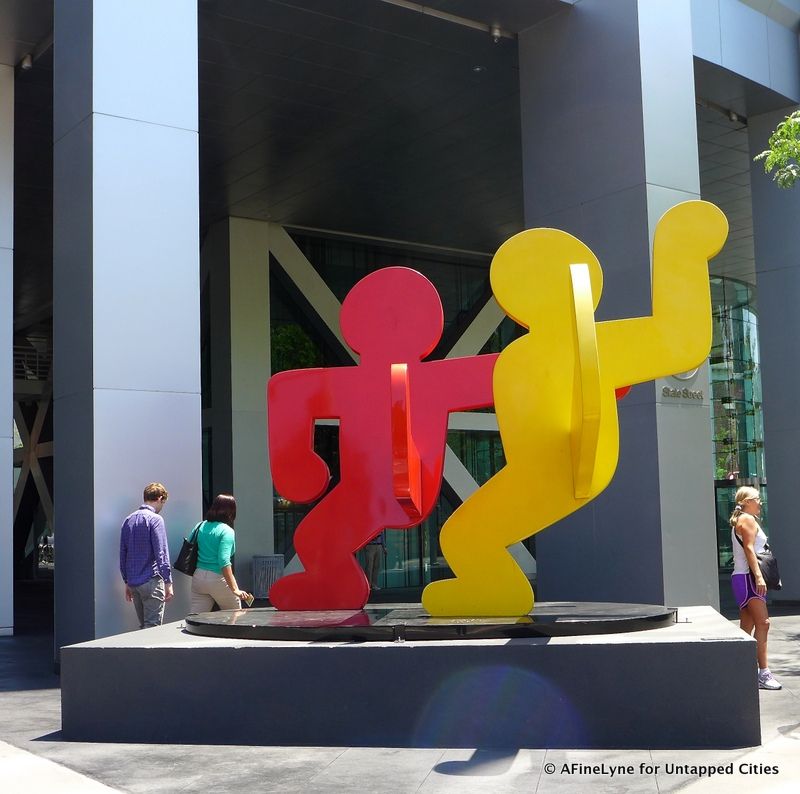
Two Dancing Figures, 1989. Artist Keith Haring
In 2003, RFR Realty President Aby Rosen and private dealer Alberto Mugrabi formed the Lever House Art Collection. This collection can be seen at many of their buildings, including the two Keith Haring sculptures on the plaza in front of 17 State Street. Keith Haring who began his artistic career drawing cartoons with his father. He enrolled in the School of Visual Arts in 1978 and rapidly moved forward in his artistic endeavors, gaining prominence in the world of graffiti and whimsical sculptures. His work can be found throughout the five boroughs.
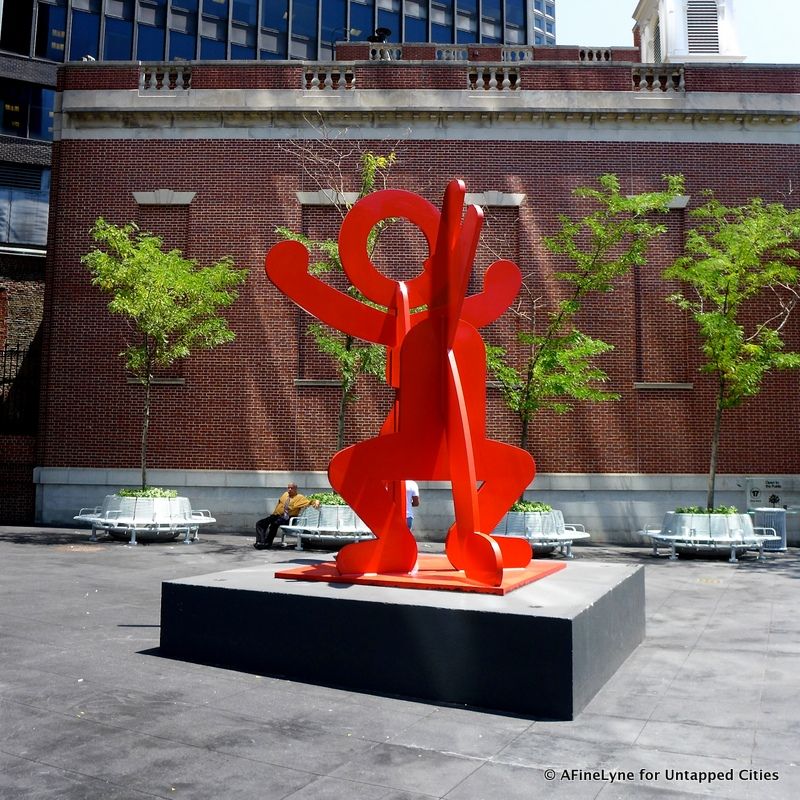
Balancing on Dog, 1986 at 17 State Street. Artist Keith Haring
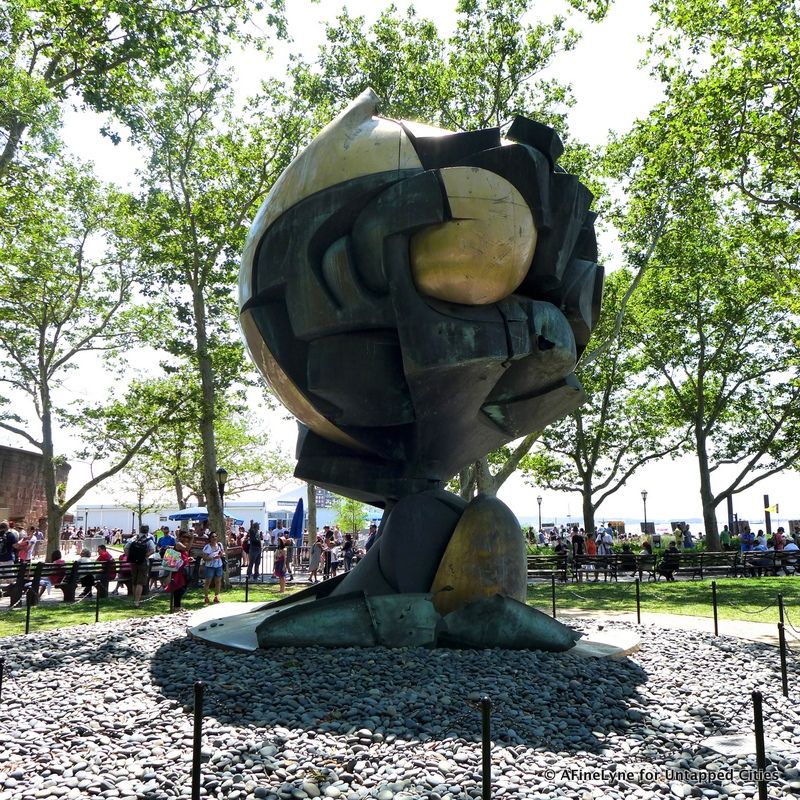
The Sphere, standing twenty-five feet tall, was to symbolize world peace through world trade, and for three decades stood at the center of the plaza of the World Trade Center. Five month after the September 11 attacks, the sculpture was recovered from the rubble and moved to The Battery. It has been at this location since March 11, 2002, and formally rededicated with an eternal flame as a memorial to the victims of September 11. The artwork is the creation of German sculptor Fritz Koenig, and now stands, as it was found – with dents and holes – as a symbol of the indestructible spirit of this country.
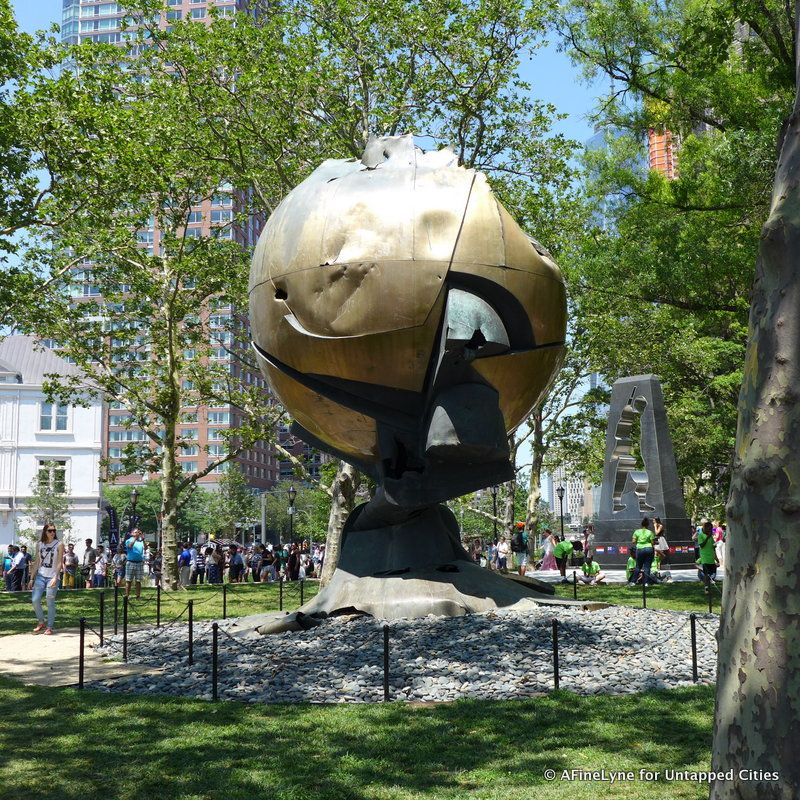
Now located at The Battery, The Sphere as it was found after September 11
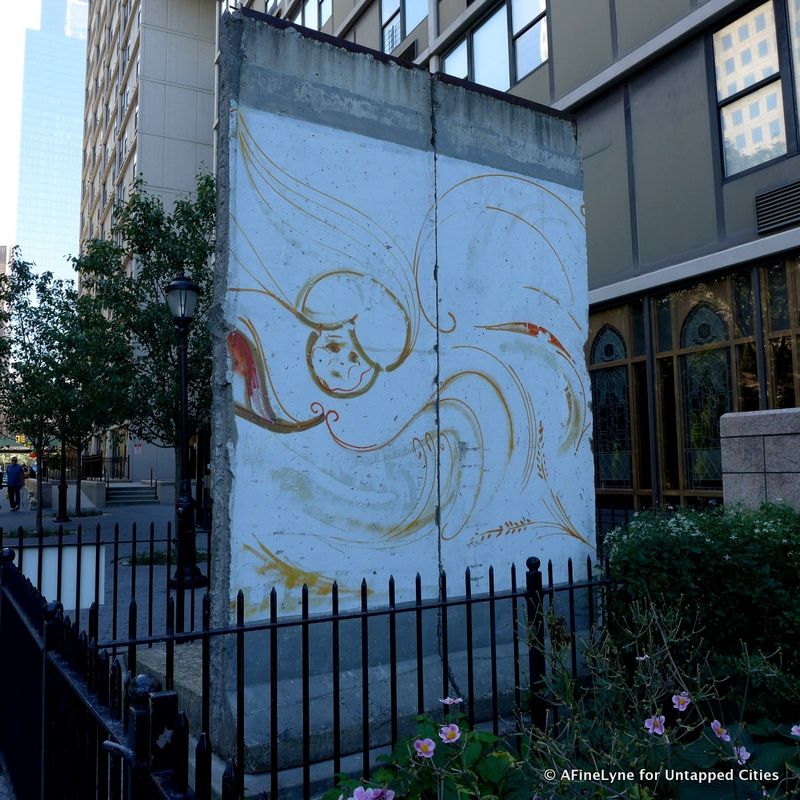
Artist Kiddy Citny, who often painted with Thierry Noir
A concert by the Juilliard School of Conservatory of Music and the Hochschule fur Musik Hanns Eisler Berlin took place in Battery Park City in 2004, overlooking the Statue of Liberty. It was on this occasion, which was also the 15th anniversary of the fall of the Berlin Wall, that these two wall slabs were gifted to New York, and given a permanent home on Kowsky Plaza at Battery Park. The 12′ high by 8′ wide pieces once stood between Potsdamer Platz and Leipzig Platz. These sections now stand back-to-back directly in front of Saint Joseph’s Chapel in the North Cove on Kowsky Plaza, which is named for Monsignor John J. Kowsky (1922-1988), a former chaplain for the new York Police Department.
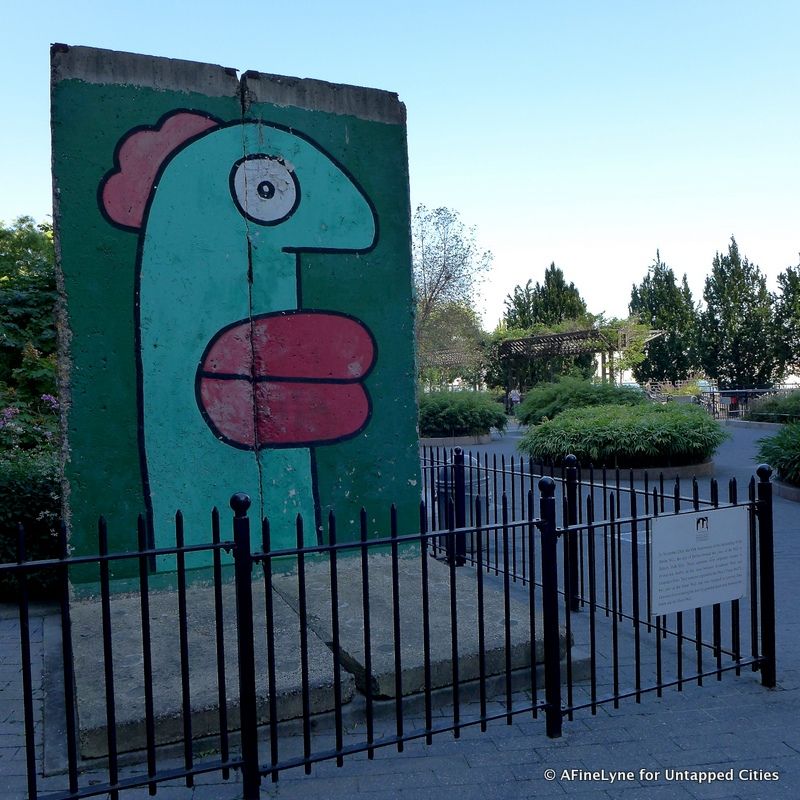
Section of the Berlin Wall painted by French artist Thierry Noir “Big Heads”
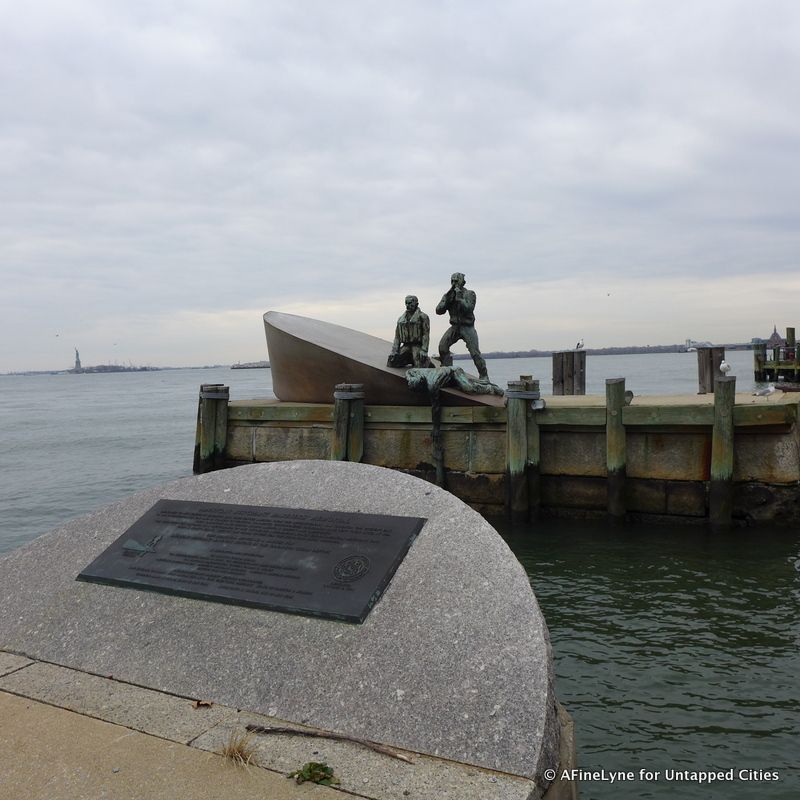
The American Merchant Mariners’ Memorial, designed by sculptor Marisol Escobar, sits on a breakwater just south of Pier A. The Bronze depicts four merchant seamen on their sinking vessel after an attack by a u-boat during World War II, with one seaman being pulled up out of the water.
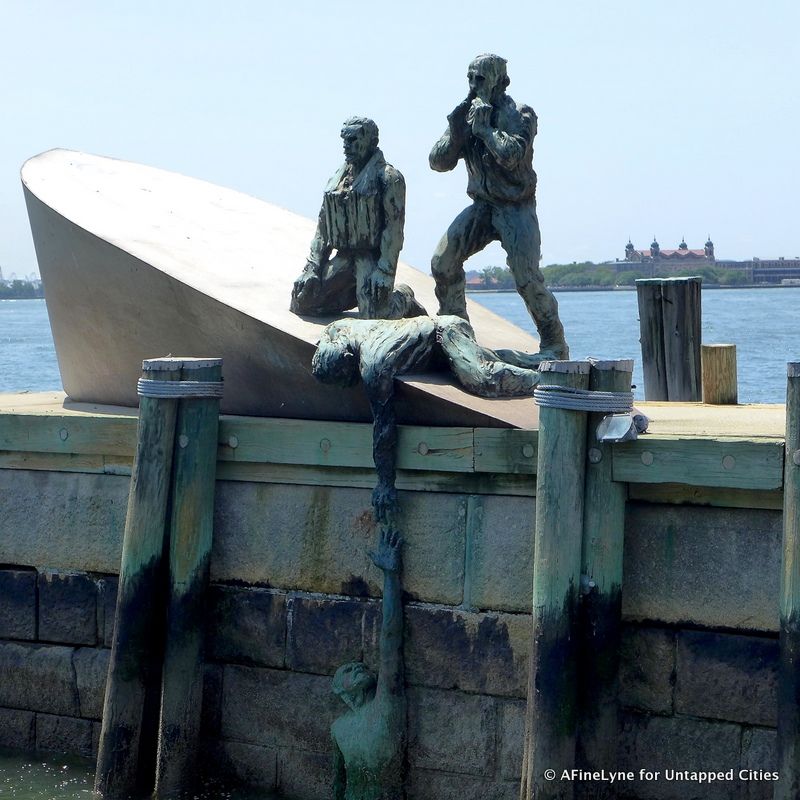
Also of note at that location, is an inscription on the walkway indicating where the shoreline of the Battery was in 1886. There were many such shoreline extensions.
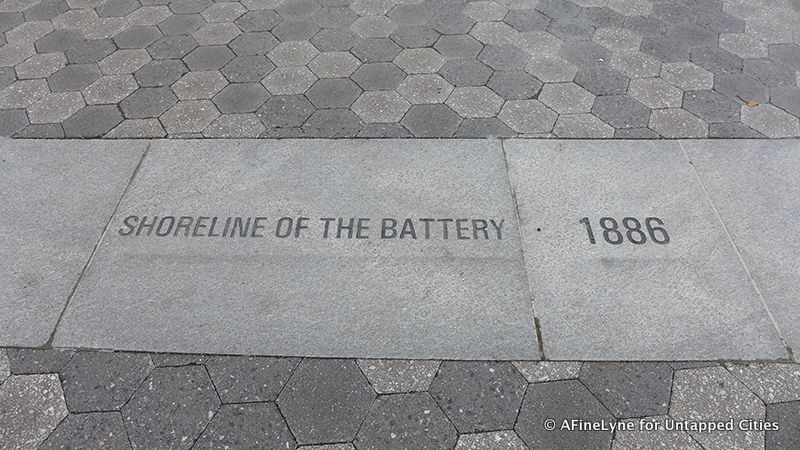
The shoreline location in 1886, on the walkway in front of the American Merchant Mariners’ Memorial
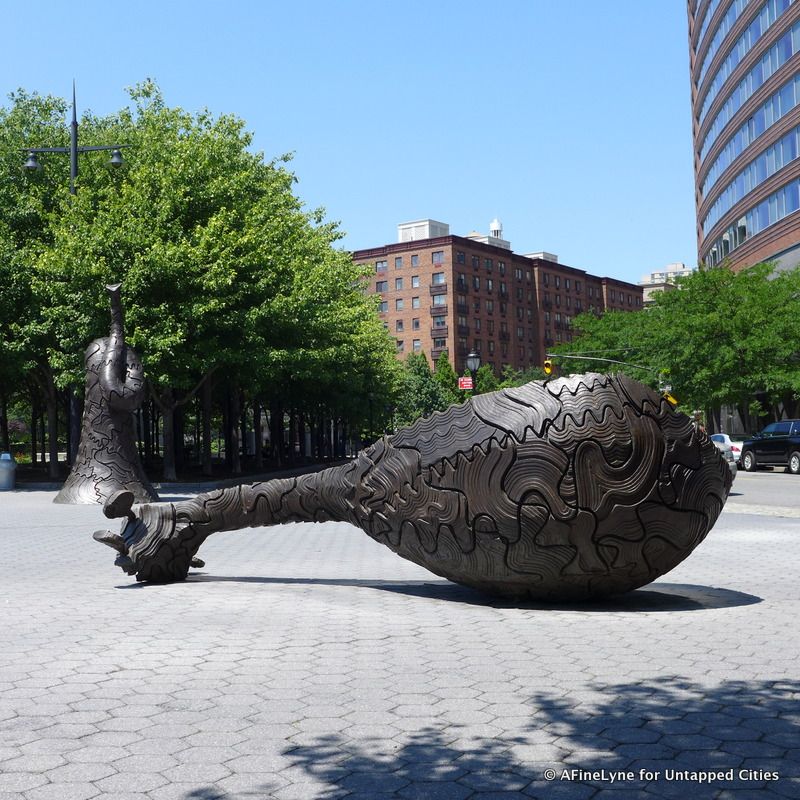
“Resonating Bodies,” 1966 by sculptor Tony Cragg
Taking a walk along the Esplanade of Battery Park City, you will view a dozen site-specific installations from Pier A to Rockefeller Park. Beginning at the entrance to Robert F. Wagner Jr. Park with the installation pictured above, Resonating Bodies by British artist Tony Cragg. Eyes by French-born artist Louise Bourgeois are positioned so as to overlook the Hudson, and are a big hit with children, who climb on them, around them, and even hide behind them. Jim Dine’s Ape & Cat are set back in the shade of trees near the Museum of Jewish Heritage.
Sitting/Stance by artist Richard Artschwager is a lovely place to take a break, and get off your feet. South Cove and Circle of Remembrance were created as a meditative environment, overlooking the Harbor and the Hudson River. Continuing on past Rector Gate by R.M. Fischer and The Upper Room by Ned Smyth. Pylons by Martin Puryear you might recognize as the DJ booth at the 2014 Diner en Blanc, and The Pavilion by Demetri Porphyrios. The Nelson A. Rockefeller Park houses sculptures by Tom Otterness – small bronze whimsical creatures in all sizes. Be sure to look closely and you will see oversized coins and tiny laborers climbing ladders – his theme and message in this installation entitled The Real World.
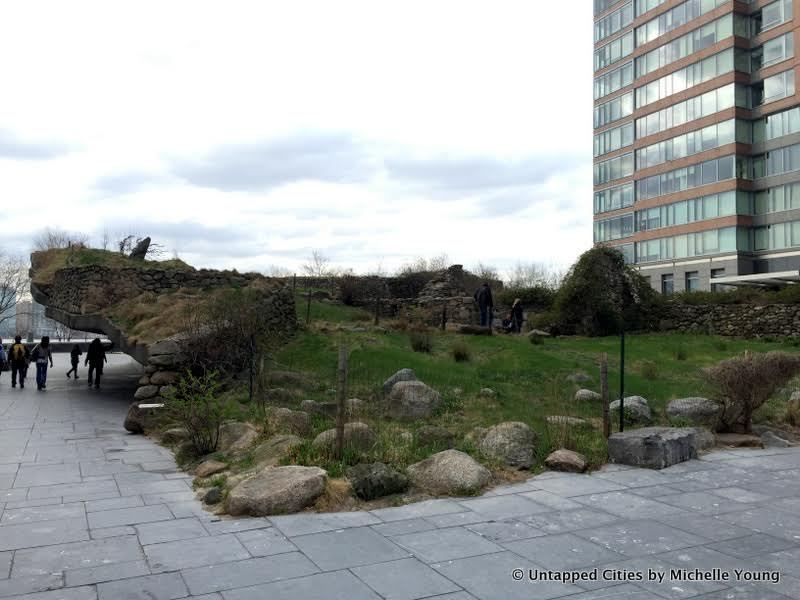
The Irish Hunger Memorial was created by artist Brian Tolle, and designed collaboratively with landscape architect Gail Wittwer-Laird. Its purpose is to raise public awareness of the events that led to the famine of 1845-52, during which time over one and a half million Irish lost their lives due to famine related deaths. It is also designed to encourage efforts to address current and future hunger worldwide. The half-acre memorial site contains an authentic famine-era cottage, which was donated by the artists family – the Slacks of Attymass, County Mayo, Ireland. The memorial consists of winding paths over rugged landscape, ending twenty-five feet above the ground with a view of the Statue of Liberty and Ellis Island. The Irish Hunger Memorial is located within Battery Park City, at North End Avenue and Vesey Street.
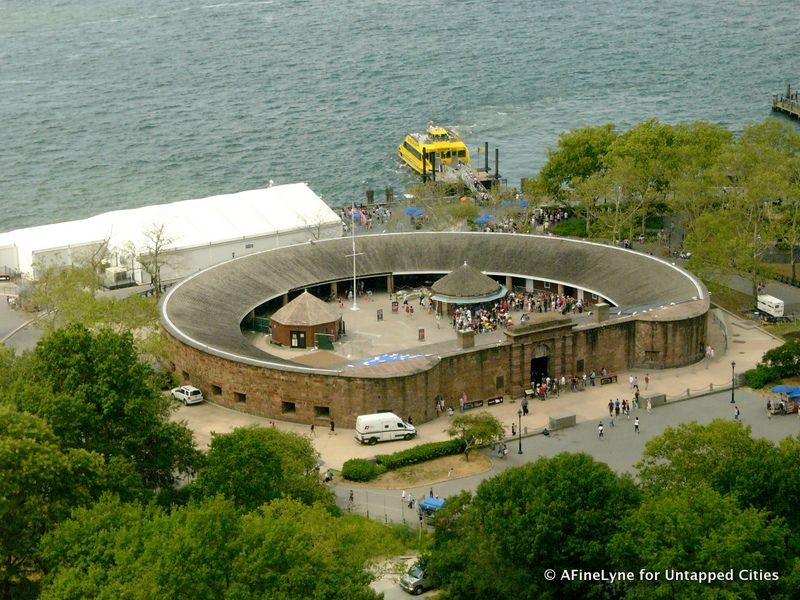
Built in anticipation of the war of 1812, Southwest Battery never had occasion to fire upon the enemy. In 1817, the fort was renamed Castle Clinton in honor of Dewitt Clinton, Mayor and later Governor of New York. In 1823, the fort was deeded to New York City, and the following year, its name was changed to Castle Garden to reflect its rebirth as a restaurant and entertainment center. With a large influx of immigrants landing at docks near Castle Clinton, it reopened as a landing depot and the official immigrant processing center in 1855. The Federal Government took over control of the immigration processing, and the function of processing was moved to a larger and more isolated facility, Ellis Island.
In 1896, Castle Garden became the New York City Aquarium, housing 150 specimens. The popular attraction received over 30,000 visitors on opening day, and remained the city’s most popular attraction until 1941, when the Park Commissioner, Robert Moses, fought to tear the historic structure down in order to build a crossing from the Battery to Brooklyn. Preservationists mobilized and the structure was designated a National Monument in 1946.
You can catch a glimpse of Castle Garden in its aquarium days in this video, the oldest surviving footage of New York City’s landmarks. The Aquarium moved to Coney Island, and Castle Garden underwent a major rehabilitation in the 1970s. Today it is administered by the National Park Service, and is used as a departure point for tourists sailing to Ellis Island and the Statue of Liberty.
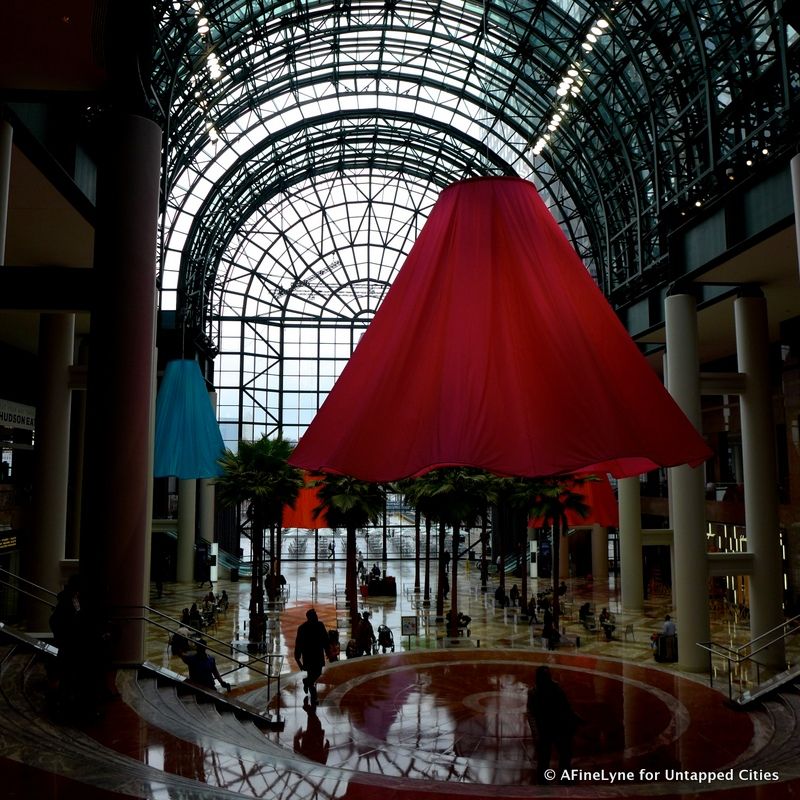
Soft Spin, sculptural and sound installation by Heather Nicol on view in April of 2015
Designed by Cesar Pelli, and originally known as the World Financial Center, Brookfield Place located at 230 Vesey Street includes the 10-story glass-vaulted pavilion known as the Winter Garden Atrium. The atrium was severely damaged in the September 11 attacks, but reconstruction at a cost of $50 million, allowing the atrium to reopen in September 2002. This was the first major structure to be completely restored following the attacks, and serves as a center for revolving art installation through ArtsBrookfield. Coming up in April, expect to see giant bunnies in the atrium in the project Intrude by artist Amanda Parer. In May, the America’s Cup World Series will have its finish just off the plaza.
Read more about the history of downtown Manhattan. Contact the author at AFineLyne.
Subscribe to our newsletter